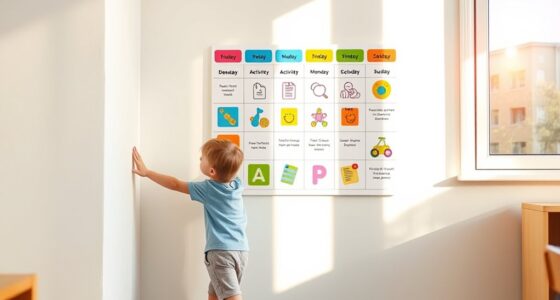After your child’s tantrum, give them space to calm down and avoid rushing in immediately. When they’re ready, gently acknowledge their feelings and validate their emotions, showing understanding and reassurance. Use calm, empathetic communication and model healthy emotional regulation yourself. Consistently follow through on promises to rebuild trust and reinforce a secure attachment. Over time, these thoughtful responses strengthen your bond and help your child develop better coping skills—discover more ways to facilitate connection beyond the tantrum.
Key Takeaways
- Allow the child time to calm down before engaging in discussion.
- Validate their feelings with empathetic statements to foster trust and emotional safety.
- Use gentle touch or soothing voice to reinforce presence and reassurance.
- Encourage the child to express their emotions and help them articulate feelings calmly.
- Reinforce the parent-child bond through consistent, supportive responses and emotional understanding.

After a tantrum, the way you approach repair and reconnection can make all the difference in restoring trust and emotional safety. When a child has just expressed intense feelings or acted out, your response sets the stage for healing. Your goal is to help them regain emotional regulation and feel secure enough to reconnect. This process isn’t about punishment; it’s about understanding, patience, and consistent reassurance. When you respond calmly and empathetically, you show your child that even difficult moments can be addressed with care, fostering trust building between you.
First, give your child space to process their emotions. Sometimes, a child needs a moment to calm down before they’re ready to talk. During this time, avoid rushing or dismissing their feelings. Instead, offer a gentle presence—perhaps a reassuring touch or a soothing voice—that communicates safety and understanding. When they’re ready, invite them to share what they’re feeling, helping them articulate their emotions. This step encourages emotional regulation, teaching your child to identify and manage their feelings rather than acting out impulsively. As they learn to regulate their emotions, they’ll develop better coping skills, reducing the likelihood of future tantrums.
Once they’re calmer, focus on rebuilding trust. Acknowledge their feelings without judgment and validate their experience. For example, you might say, “I see you’re really upset, and that’s okay. It’s normal to feel overwhelmed sometimes.” This validation reassures your child that their emotions are valid and understood, creating a foundation for trust building. Be consistent in your responses, following through on promises and setting clear boundaries. Consistency shows your child that they can rely on you to be present and supportive, which strengthens their emotional safety.
It’s also important to model healthy emotional regulation yourself. Share how you manage your feelings during stressful moments, demonstrating that everyone experiences difficult emotions but that they can be handled constructively. This modeling helps your child learn appropriate ways to cope and contributes to a secure attachment. Incorporating divorce-related communication strategies can also support your child’s emotional stability during these times. Over time, these repair efforts reinforce your relationship, making your child feel heard, valued, and safe. Remember, the goal isn’t perfection but progress—each calm, compassionate response builds a stronger foundation of trust and emotional resilience, helping your child navigate their feelings and develop healthier emotional habits.
Frequently Asked Questions
How Long Does It Typically Take to Fully Repair After a Tantrum?
It usually takes a few hours to a couple of days for you to fully repair after a tantrum. During this time, emotional healing happens as you process your feelings, and conflict resolution begins to restore trust. Be patient and gentle with yourself, allowing space for reflection and calmness. Remember, everyone’s healing timeline differs, but consistent self-care and understanding speed up the reconnection process.
Are There Specific Signs That Indicate Successful Reconnection?
You’ll notice successful reconnection through clear emotional signals, like your child’s relaxed posture and genuine eye contact, showing they feel safe again. Physical cues such as calm breathing and a gentle touch also indicate they’re reconnecting. If your child responds with soft words or smiles, it means trust is restored. These signs reveal they’re emotionally and physically re-engaged, confirming that your repair efforts have worked and the connection is strengthening.
What Common Mistakes Should I Avoid During Repair?
Imagine trying to mend a delicate glass sculpture—you must handle it carefully. Avoid emotional misreading by misinterpreting your child’s feelings, and never respond inconsistently, like offering comfort one moment and ignoring the next. These mistakes can cause confusion and hinder reconnection. Stay calm, consistent, and empathetic, ensuring your responses match their emotional cues. This approach fosters trust and helps rebuild a secure connection after a tantrum.
Can Children Recover From Tantrums Without Parental Intervention?
Yes, children can recover from tantrums without parental intervention by developing independent recovery skills. When they learn to manage their emotions and calm themselves, they build emotional resilience. You should encourage your child to practice self-soothing techniques, like deep breathing or taking a break. Supporting their independence helps them handle future tantrums more effectively, fostering confidence and emotional strength without always needing your immediate involvement.
How Can I Prevent Future Tantrums and Improve Reconnection?
You can prevent future tantrums and improve reconnection by fostering your child’s emotional resilience and establishing consistent routines. Encourage open communication, validate their feelings, and teach coping strategies. Maintain predictable daily schedules so they feel secure and understand expectations. When tantrums occur, stay calm, reinforce trust, and reconnect through gentle touch or words. This consistency and emotional support help your child develop resilience, reducing future outbursts and strengthening your bond.
Conclusion
When you take the time to repair and reconnect after a tantrum, you strengthen your bond and build trust. Remember, studies show that children who experience consistent repair are 40% more likely to develop secure attachments. So, next time things get tense, stay calm, listen, and reconnect. Your efforts not only soothe the moment but also foster emotional resilience and a stronger relationship for years to come.










